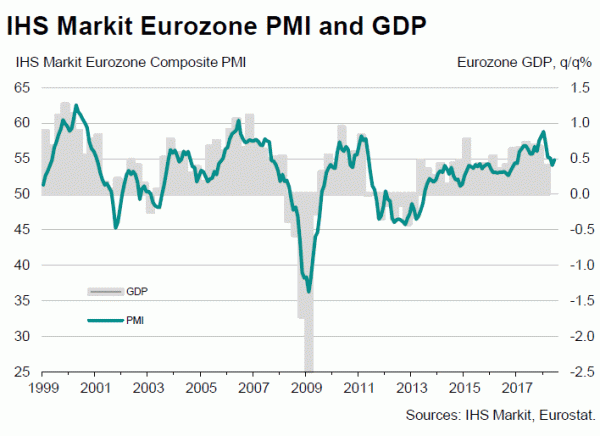Eurozone PMI manufacturing dropped to 55.0 in June, down from 55.5 and met expectation. PMI services rose to 55.0, up from 53.8 and beat expectation of 53.7. PMI composite rose to 54.8, up from 54.1 and beat expectation of 53.9. PMI composite is at a 2 month high while PMI services is at at 4-month high. However, PMI manufacturing is at an 18-month low. Overall, the data point to 0.5% GDP growth in Q2.
Commenting on the flash PMI data, Chris Williamson, Chief Business Economist at IHS Markit said:
“An improved service sector performance helped offset an increasing drag from the manufacturing sector in June, lifting Eurozone growth off the 18- month low seen in May. With growth kicking higher in June, the surveys are commensurate with GDP rising 0.5% in the second quarter.
“Price pressures are also on the rise again, running close to seven-year highs. Increased oil and raw material prices are driving up costs, but wages are also lifting higher, in part reflecting tighter labour markets in some parts of the region. Service sector jobs are being created at the fastest rate seen over the past decade, underscoring the extent to which the job market is tightening.
“However, the details of the survey warn against any complacency. The June uptick could be at least in part explained by business returning to normal after an unusually high number of public holidays in May, suggesting that the underlying trend remains one of slower growth. Business expectations are running at one-and-a-half year lows, and output continues to increase at a faster rate than incoming new orders, all of which suggests that output and employment growth could weaken again in July unless demand picks up again.
“Manufacturing is looking especially prone to a further slowdown in coming months, with companies citing trade worries and political uncertainty as their biggest concerns. Sentiment about the year ahead in the factory sector has sunk to its lowest since 2015.
“While the June upturn provides some hope that the weakening of official data earlier in the year may have overstated the region’s weakness, the risks remained tilted towards a further slowdown in the second half of the year.”












